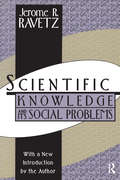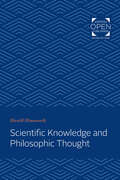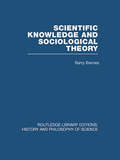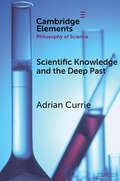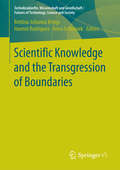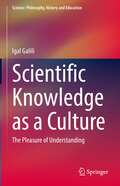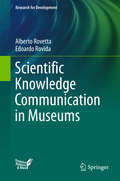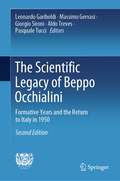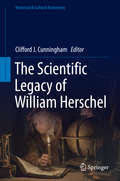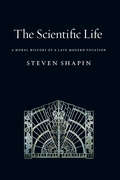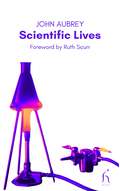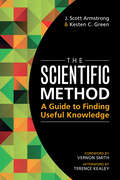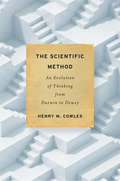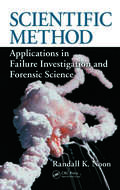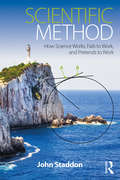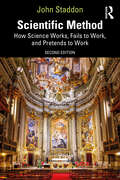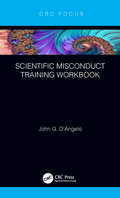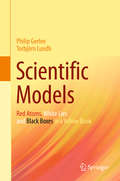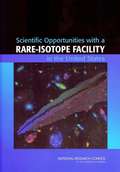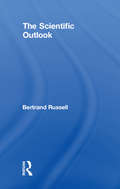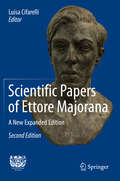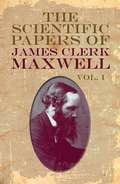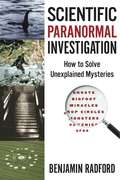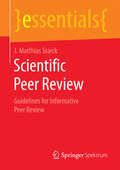- Table View
- List View
Scientific Knowledge and Its Social Problems
by Jerome R. RavetzScience is continually confronted by new and difficult social and ethical problems. Some of these problems have arisen from the transformation of the academic science of the prewar period into the industrialized science of the present. Traditional theories of science are now widely recognized as obsolete. In Scientific Knowledge and Its Social Problems (originally published in 1971), Jerome R. Ravetz analyzes the work of science as the creation and investigation of problems. He demonstrates the role of choice and value judgment, and the inevitability of error, in scientific research. Ravetz's new introductory essay is a masterful statement of how our understanding of science has evolved over the last two decades.
Scientific Knowledge and Philosophic Thought
by Harold HimsworthOriginally published in 1986. Are there two kinds of problems—the scientific and the philosophic—each requiring different methods for solution? Or are there, rather, two different ways of approaching a problem, each yielding a different answer according to the method used? Biomedical researcher Sir Harold Himsworth urges scientists not to shy away from using scientific methods to grapple with problems traditionally accepted as belonging to the province of philosophy. The difference between science and philosophy lies not in the problems to which they are directed, Himsworth argues, but rather in the methods they use for solving them. To the scientist, a proposition is something to be investigated; to the philosopher, something to be accepted as a basis for thought. Since the development of the scientific method, substantial progress has been made toward mastering problems in the natural environment. If we are ever to attain a degree of control over problems that derive from human activities, Himsworth claims that we only succeed by approaching them in a comparably objective way.
Scientific Knowledge and Sociological Theory (Routledge Library Editions: History & Philosophy of Science)
by Barry BarnesOriginally published in 1974. Scientific Knowledge and Sociological Theory centres on the problem of explaining the manifest variety and contrast in the beliefs about nature held in different groups and societies. It maintains that the sociologist should treat all beliefs symmetrically and must investigate and account for allegedly "correct" or "scientific" beliefs just as he would "incorrect" or "unscientific" ones. From this basic position a study of scientific beliefs is constructed. The sociological interest of such beliefs is illustrated and a sociological perspective upon scientific change is developed.
Scientific Knowledge and the Deep Past: History Matters (Elements in the Philosophy of Science)
by Adrian CurrieHistorical sciences like paleontology and archaeology have uncovered unimagined, remarkable and mysterious worlds in the deep past. How should we understand the success of these sciences? What is the relationship between knowledge and history? In Scientific Knowledge and the Deep Past: History Matters, Adrian Currie examines recent paleontological work on the great changes that occurred during the Cretaceous period - the emergence of flowering plants, the splitting of the mega-continent Gondwana, and the eventual fall of the dinosaurs - to analyse the knowledge of historical scientists, and to reflect upon the nature of history. He argues that distinctively historical processes are 'peculiar': they have the capacity to generate their own highly specific dynamics and rules. This peculiarity, Currie argues, also explains the historian's interest in narratives and stories: the contingency, complexity and peculiarity of the past demands a narrative treatment. Overall, Currie argues that history matters for knowledge.
Scientific Knowledge and the Transgression of Boundaries
by Bettina-Johanna Krings Hannot Rodríguez Anna SchleisiekThe aim of this book is to understand and critically appraise science-based transgression dynamics in their whole complexity. It includes contributions from experts with different disciplinary backgrounds, such as philosophy, history and sociology. Thus, it is in itself an example of boundary transgression. Scientific disciplines and their objects have tended to be seen as permanent and distinct. However, science is better conceived as an activity that constantly surpasses, erases and rebuilds all kinds of boundaries, either disciplinary, socio-ethical or ecological. This transgressive capacity, a characteristic trait of science and its applications, defines us as "knowledge societies. " However, scientific and technological developments are also sources of serious environmental and social concerns.
Scientific Knowledge as a Culture: The Pleasure of Understanding (Science: Philosophy, History and Education)
by Igal GaliliThis book, in its first part, contains units of conceptual history of several topics of physics based on the research in physics education and research based articles with regard to several topics involved in teaching science in general and physics in particular. The second part of the book includes the framework used, the approach considering science knowledge as a special type of culture – discipline-culture. Within this approach, scientific knowledge is considered as comprised of a few inclusive fundamental theories each hierarchically structured in a triadic pattern: nucleus-body-periphery. While nucleus incorporates the basic principles and body comprises their implementations in the variety of laws, models, and experiments, periphery includes concepts at odds to the nucleus. This structure introduces knowledge in its conceptual variation thus converting disciplinary knowledge to cultural-disciplinary one. The approach draws on history and philosophy of science (HPS) necessary for meaningful learning of science. It is exemplified in several aspects regarding teaching physics, presenting history in classes, considering the special nature of science, and using artistic images in regular teaching. The revealed conceptual debate around the chosen topics clarifies the subject matter for school students and teachers encouraging construction of Cultural Content Knowledge. Often missed in teachers' preparation and common curriculum it helps genuine understanding of science thus providing remedy of students' misconceptions reported in educational research.
Scientific Knowledge Communication in Museums (Research For Development Ser.)
by Alberto Rovetta Edoardo RovidaThis book explains the general principles of scientific and technical communication in the context of modern museums. It also examines, with the aid of informative case studies, the different means by which knowledge can be transmitted, including posters, objects, explanatory guidance, documentation, and catalogues. Highlighting the ever more important role of multimedia and virtual reality components in communicating understanding of and facilitating interaction with the displayed object, it explores how network communications systems and algorithms can be applied to offer individual users the information that is most pertinent to them. The book is supported by a Dynamic Museums app connected to museum databases where series of objects can be viewed via cloud computing and the Internet and printed using 3D printing technology. This book is of interest to a diverse readership, including all those who are responsible for museums’ collections, operations, and communications as well as those delivering or participating in courses on museums and their use, communication design and related topics.
The Scientific Legacy of Beppo Occhialini: Formative Years and the Return to Italy in 1950
by Leonardo Gariboldi Massimo Gervasi Giorgio Sironi Aldo Treves Pasquale TucciThe thirtieth anniversary of the death of Beppo Occhialini, the cosmic-ray physicist associated among other things to the fundamental discoveries of the electron-positron pairs and of the pion thanks to his contributions to the development of the controlled cloud chamber and of new nuclear emulsions, is the occasion to publish his memoirs on the main events of his scientific life, which he dictated shortly before his death. This second edition of The Scientific Legacy of Beppo Occhialini takes us by the hand to appreciate the admiration if not the veneration he had for Patrick Blackett, the ironic rudeness of Lord Rutherford, or the troubled relationship with Cecil Powell. A particularly thorny aspect concerns the role played by some physicists during the Second World War and the way Occhialini elaborated the complex personal situations experienced by each of them. Occhialini’s memoirs are enriched by his short autobiography originally published as an encyclopedia entry in the 1970s. A selection of relevant historical studies and personal reminiscences mainly concerning his scientific activity before his coming to Milan is reproposed, together with some personal notes from friends and colleagues.
The Scientific Legacy of William Herschel
by Clifford J. CunninghamThis book presents a modern scholarly analysis of issues associated with England'smost famous astronomer, William Herschel. The world's leading experts onHerschel, discoverer of the planet Uranus, here offer their combined wisdom on manyaspects of his life and astronomical research. Solar system topics includecomets, Earth's Moon, and the spurious moons of Uranus, all objects whose observation was pioneered by Herschel. The contributors examine his study of thestructure of the Milky Way and an in-depth look at the development of the front view telescopes he built. The popular subject of extraterrestriallife is looked at from the point of view of both William Herschel and his sonJohn, both of whom had an interest in the topic. William's personal development through the educational system of the lateeighteenth-century is also explored, and the wide range of verse and satire invarious languages associated with his discoveries is collected here for thefirst time. Hershel worked at a time of incredible discovery, and his work is still highly regarded in the field. Here it is given a thorough investigation which puts into context and perspective his path breaking career.
The Scientific Life: A Moral History of a Late Modern Vocation
by Steven ShapinConventional wisdom has long held that scientists are neither better nor worse than anyone else, that personal virtue does not necessarily accompany technical expertise, and that scientific practice is profoundly impersonal. Shapin, however, here shows how the uncertainties attending scientific research make the virtues of individual researchers intrinsic to scientific work. Further, Shapin argues that the radical uncertainties of much of contemporary science have made personal virtues more central to its practice than ever before, and he also reveals how radically novel aspects of late modern science have unexpectedly deep historical roots.
Scientific Lives (Hesperus Classics)
by John Aubrey"The honourable Robert Boyle esq., the son of Richard Boyle, the first Earl of Cork, was born at Lismore in the county of Cork. He was nursed by an Irish nurse, after the Irish manner, where they put the child in a pendulous satchel instead of a cradle, with a slit for the child's head to peep out." This new selection from John Aubrey's enormous work of 17th-century biography, Brief Lives, brings together his writings on contemporary scientists, explorers and men of innovation, including astronomer Edmund Halley, celebrated mapmaker Wenceslaus Hollar, and the architects Christopher Wren and Inigo Jones. Simultaneously quirky, amusing, and informative, these pieces together provide a fascinating portrait of an exciting and inventive age.
The Scientific Method: A Guide to Finding Useful Knowledge
by J. Scott Armstrong Kesten C. GreenThe scientific method delivers prosperity, yet scientific practice has become subject to corrupting influences from within and without the scientific community. This essential reference is intended to help remedy those threats. The authors identify eight essential criteria for the practice of science and provide checklists to help avoid costly failures in scientific practice. Not only for scientists, this book is for all stakeholders of the broad enterprise of science. Science administrators, research funders, journal editors, and policymakers alike will find practical guidance on how they can encourage scientific research that produces useful discoveries. Journalists, commentators, and lawyers can turn to this text for help with assessing the validity and usefulness of scientific claims. The book provides practical guidance and makes important recommendations for reforms in science policy and science administration. The message of the book is complemented by Nobel Laureate Vernon L. Smith's foreword, and an afterword by Terence Kealey.
The Scientific Method: An Evolution of Thinking from Darwin to Dewey
by Henry M. CowlesThe surprising history of the scientific method—from an evolutionary account of thinking to a simple set of steps—and the rise of psychology in the nineteenth century. The idea of a single scientific method, shared across specialties and teachable to ten-year-olds, is just over a hundred years old. For centuries prior, science had meant a kind of knowledge, made from facts gathered through direct observation or deduced from first principles. But during the nineteenth century, science came to mean something else: a way of thinking. The Scientific Method tells the story of how this approach took hold in laboratories, the field, and eventually classrooms, where science was once taught as a natural process. Henry M. Cowles reveals the intertwined histories of evolution and experiment, from Charles Darwin’s theory of natural selection to John Dewey’s vision for science education. Darwin portrayed nature as akin to a man of science, experimenting through evolution, while his followers turned his theory onto the mind itself. Psychologists reimagined the scientific method as a problem-solving adaptation, a basic feature of cognition that had helped humans prosper. This was how Dewey and other educators taught science at the turn of the twentieth century—but their organic account was not to last. Soon, the scientific method was reimagined as a means of controlling nature, not a product of it. By shedding its roots in evolutionary theory, the scientific method came to seem far less natural, but far more powerful. This book reveals the origin of a fundamental modern concept. Once seen as a natural adaptation, the method soon became a symbol of science’s power over nature, a power that, until recently, has rarely been called into question.
Scientific Method: Applications in Failure Investigation and Forensic Science (International Forensic Science and Investigation)
by Randall K. NoonMost failure or accident investigations begin at the end of the story: after the explosion, after the fire has been extinguished, or after the collapse. In many instances, information about the last event and the starting event is known reasonably well. Information about what occurred between these endpoints, however, is often unclear, confusing, and perhaps contradictory. Scientific Method: Applications in Failure Investigation and Forensic Science explains how scientific investigative methods can best be used to determine why and how a particular event occurred.While employing examples from forensic engineering, the book uses principles and ideas applicable to most of the forensic sciences. The author examines the role of the failure investigator, describes the fundamental method for investigation, discusses the optimal way to organize evidence, and explores the four most common reasons why some investigations fail. The book provides three case studies that exemplify proper report writing, contains a special chapter profiling a criminal case by noted forensic specialist Jon J. Nordby, and offers a reading list of resources for further study.Concise and illustrative, this volume demonstrates how the scientific method can be applied to failure investigation in ways that avoid flawed reasoning while delivering convincing reconstruction scenarios. Investigators can pinpoint where things went wrong, providing valuable information that can prevent another catastrophe.
Scientific Method: How Science Works, Fails to Work, and Pretends to Work
by John StaddonThis book shows how science works, fails to work, or pretends to work, by looking at examples from such diverse fields as physics, biomedicine, psychology, and economics. Social science affects our lives every day through the predictions of experts and the rules and regulations they devise. Sciences like economics, sociology and health are subject to more ‘operating limitations’ than classical fields like physics or chemistry or biology. Yet, their methods and results must also be judged according to the same scientific standards. Every literate citizen should understand these standards and be able to tell the difference between good science and bad. Scientific Method enables readers to develop a critical, informed view of scientific practice by discussing concrete examples of how real scientists have approached the problems of their fields. It is ideal for students and professionals trying to make sense of the role of science in society, and of the meaning, value, and limitations of scientific methodology in the social sciences.
Scientific Method: How Science Works, Fails to Work, and Pretends to Work
by John StaddonThis expanded second edition of Scientific Method shows how science works, fails to work or pretends to work by looking at examples from physics, biomedicine, psychology, sociology and economics.Scientific Method aims to help curious readers understand the idea of science, not by learning a list of techniques but through examples both historical and contemporary. Staddon affirms that if the reader can understand successful studies as well as studies that appear to be scientific but are not, they will become a better judge of the “science” in circulation today. To this end, this new edition includes a new chapter, What is Science?, which points out that science, like any human activity, has its own set of values, with truth being the core. Other new chapters focus on the emergence of AI and machine learning, science and diversity, and behavioral economics. The book also includes textual features such as bullet-points and text boxes on topical issues.Scientific Method is essential reading for students and professionals trying to make sense of the role of science in society, and of the meaning, value and limitations of scientific methodology.
Scientific Method in Brief
by Hugh G. Gauch Jr.The fundamental principles of the scientific method are essential for enhancing perspective, increasing productivity, and stimulating innovation. These principles include deductive and inductive logic, probability, parsimony and hypothesis testing, as well as science's presuppositions, limitations, ethics and bold claims of rationality and truth. The examples and case studies drawn upon in this book span the physical, biological and social sciences; include applications in agriculture, engineering and medicine; and also explore science's interrelationships with disciplines in the humanities such as philosophy and law. Informed by position papers on science from the American Association for the Advancement of Science, National Academy of Sciences and National Science Foundation, this book aligns with a distinctively mainstream vision of science. It is an ideal resource for anyone undertaking a systematic study of scientific method for the first time, from undergraduates to professionals in both the sciences and the humanities.
Scientific Misconduct Training Workbook (Global Science Education)
by John Gaetano D'AngeloThe field of ethics in science aims to improve the way the audience perceives science, and this unique workbook discusses the areas of ethics and scientific misconduct. It provides assessments and exercises for learners to work through in groups or alone. Completion of the workbook but especially the assessment and tests will earn the learner a certificate for scientific misconduct training compiled by the author, and the certificate is available from the author's own website. This volume is a companion to the author's published volume, Ethics in Science: Ethical Misconduct in Scientific Research, Second Edition and will appeal to undergraduates, graduates and even high school students. Features: A unique training workbook in ethics and good conduct, easliy accessible and user friendly Unlike books in this area which mostly cover the theoretical foundations of ethics in science, here the author provides a practical workbook and ancillaries Case studies and a PowerPoint presentation are provided and readers will receive a certificate of completion There is a wealth of instructor resources available from the homepage A knowledge of scientific misconduct is of utmost importance in an era of mass higher education
Scientific Models
by Philip Gerlee Torbjörn LundhA zebrafish, the hull of a miniature ship, a mathematical equation and a food chain - what do these things have in common? They are examples of models used by scientists to isolate and study particular aspects of the world around us. This book begins by introducing the concept of a scientific model from an intuitive perspective, drawing parallels to mental models and artistic representations. It then recounts the history of modelling from the 16th century up until the present day. The iterative process of model building is described and discussed in the context of complex models with high predictive accuracy versus simpler models that provide more of a conceptual understanding. To illustrate the diversity of opinions within the scientific community, we also present the results of an interview study, in which ten scientists from different disciplines describe their views on modelling and how models feature in their work. Lastly, it includes a number of worked examples that span different modelling approaches and techniques. It provides a comprehensive introduction to scientific models and shows how models are constructed and used in modern science. It also addresses the approach to, and the culture surrounding modelling in different scientific disciplines. It serves as an inspiration for model building and also facilitates interdisciplinary collaborations by showing how models are used in different scientific fields. The book is aimed primarily at students in the sciences and engineering, as well as students at teacher training colleges but will also appeal to interested readers wanting to get an overview of scientific modelling in general and different modelling approaches in particular.
Scientific Opportunities with a RARE-ISOTOPE FACILITY in the United States
by National Research Council of the National AcademiesOver ten years ago, U.S. nuclear scientists proposed construction of a new rare isotope accelerator in the United States, which would enable experiments to elucidate the important questions in nuclear physics. To help assess this proposal, DOE and NSF asked the NRC to define the science agenda for a next-generation U.S. Facility for Rare Isotope Beams (FRIB). As the study began, DOE announced a substantial reduction in the scope of this facility and put off its initial operation date by several years. The study focused on an evaluation of the science that could be accomplished on a facility reduced in scope. This report provides a discussion of the key science drivers for a FRIB, an assessment of existing domestic and international rare isotope beams, an assessment of the current U.S. position about the FRIB, and a set of findings and conclusions about the scientific and policy context for such a facility.
The Scientific Outlook (Routledge Classics Ser.)
by Bertrand Russell'A scientific opinion is one which there is some reason to believe is true; an unscientific opinion is one which is held for some reason other than its probable truth.' - Bertrand RussellOne of Russell's most important books, this early classic on science illuminates his thinking on the promise and threat of scientific progress. Russell considers three questions fundamental to an understanding of science: the nature and scope of scientific knowledge, the increased power over nature that science affords, and the changes in the lives of human beings that result from new forms of science. With customary wit and clarity, Russell offers brilliant discussions of many major scientific figures, including Aristotle, Galileo, Newton and Darwin.With a new introduciton by David Papineau, King's College, London.
Scientific Papers of Ettore Majorana: A New Expanded Edition
by Luisa CifarelliThis book presents in full the work of the Italian theoretical physicist Ettore Majorana and explains its impacts, which are still being felt. It opens with a contribution by A. Zichichi that considers in depth the scientifi c genius of Majorana. This introductorychapter is followed, in chronological order, by the eleven scientifi c papers by this great scientist, in most cases translated into English for the fi rst time. Each paper is accompanied by a comment from an expert in the fi eld in question. Although very few in number, Majorana’s papers constitute a heritage of undeniable value and extraordinary scientifi c meaning, since they laid the foundations for research fi elds that remain topical today. With this in mind, two additional contributions on ongoing developments in these research fi elds are included: one on neutrino physics and the other on Majorana fermions in condensed matter. The volume closes with a note on Majorana’s life until his ill-fated disappearance.
The Scientific Papers of James Clerk Maxwell, Vol. I
by James Clerk MaxwellOne of the greatest theoretical physicists of the 19th century, James Clerk Maxwell is best known for his studies of the electromagnetic field. The 101 scientific papers of this two-volume set, arranged chronologically, testify to Maxwell's profound scientific legacy and include the preliminary explorations that culminated in his most famous work, A Treatise on Electricity and Magnetism. One of the nineteenth century's most significant papers, "A Dynamical Theory of the Electromagnetic Field," appears here, along with similarly influential expositions of Maxwell's dynamical theory of gases. The author's extensive range of interests is well represented, from his discussions of color blindness and the composition of Saturn's rings to his essays on geometrical optics, ether, and protecting buildings from lightning. His less technical writings are featured as well, including items written for the Encyclopedia Britannica and Nature magazine, book reviews, and popular lectures. Striking in their originality, these papers offer a wealth of stimulating and inspiring reading to modern students of mathematics and physics.
Scientific Paranormal Investigation: How to Solve Unexplained Mysteries
by Benjamin RadfordThis book is about the scientific methods used to investigate mysteries with real life case studies and how they were solved.
Scientific Peer Review: Guidelines for Informative Peer Review (essentials)
by J. Matthias StarckJ. Matthias Starck comprehensively guides the reader in this essential through all steps of writing an expert review for a scientific journal. It is built on a succinct analysis how science works, how science is communicated and how science is published. It provides a critical guide how to write good, informative and fair peer reviews. The author presents a critical discussion of different peer review procedures and their alternatives, explains ethical guidelines as well as the dark sides of scientific publishing. So this essential helps the reader to perform better in the existing system and to contribute to its further development and improvement.
